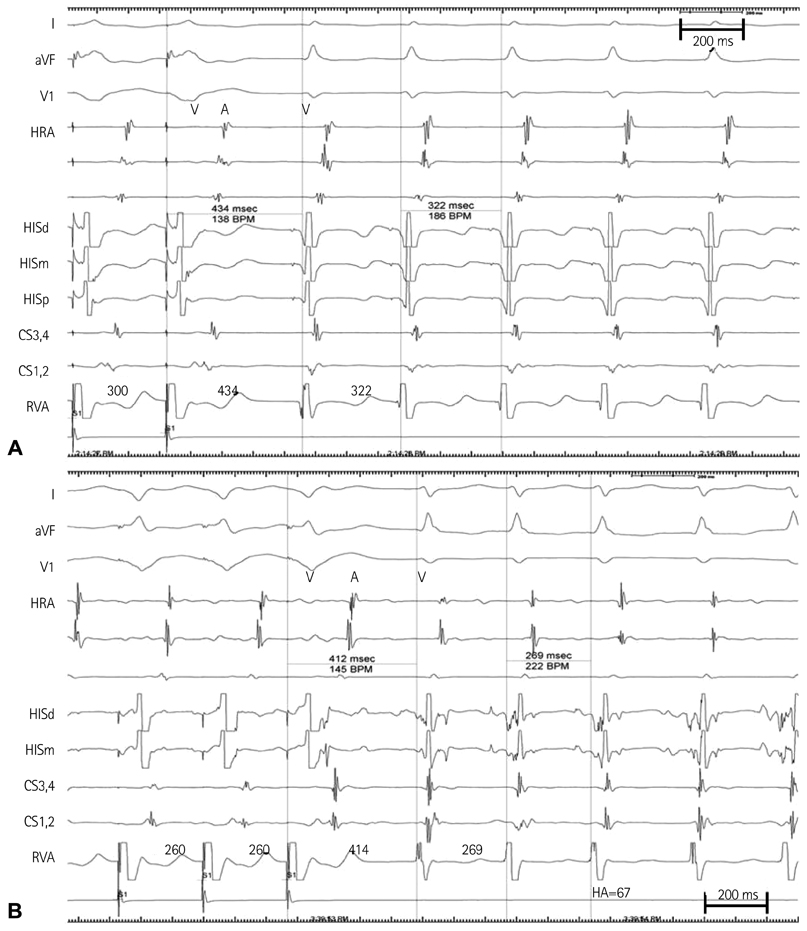Korean Circ J.
2012 Oct;42(10):718-721. 10.4070/kcj.2012.42.10.718.
Familial Occurrence of Atrioventricular Nodal Reentrant Tachycardia in a Mother and Her Son
- Affiliations
-
- 1Division of Cardiology, Department of Internal Medicine, Inje University College of Medicine, Ilsan Paik Hospital, Goyang, Korea. jnamgung@paik.ac.kr
- KMID: 1826472
- DOI: http://doi.org/10.4070/kcj.2012.42.10.718
Abstract
- Atrioventricular nodal reentrant tachycardia (AVNRT), caused by a reentry circuit involving fast and slow atrioventricular nodal pathways, is one of the most common types of paroxysmal supraventricular tachycardias. While familial Wolff-Parkinson-White syndrome has been well recognized, familial AVNRT has been rarely reported. We report a familial occurrence of AVNRT in a mother and her son, who were symptomatic and successfully treated with radiofrequency catheter ablation of slow pathway.
MeSH Terms
Figure
Reference
-
1. Vidaillet HJ Jr, Pressley JC, Henke E, Harrell FE Jr, German LD. Familial occurrence of accessory atrioventricular pathways (preexcitation syndrome). N Engl J Med. 1987. 317:65–69.2. Brugada R, Tapscott T, Czernuszewicz GZ, et al. Identification of a genetic locus for familial atrial fibrillation. N Engl J Med. 1997. 336:905–911.3. Wan Q, Wu N, Fan W, Tang YY, Jin L, Fang Q. Clinical manifestations and prevalence of different types of supraventricular tachycardia among Chinese. Chin Med J (Engl). 1992. 105:284–288.4. Gollob MH, Green MS, Tang AS, et al. Identification of a gene responsible for familial Wolff-Parkinson-White syndrome. N Engl J Med. 2001. 344:1823–1831.5. Kang BH, Kim HJ, Namgung J, et al. Wolff-Parkinson-White syndrome treated with radiofrequency ablation in father and his son. Korean Circ J. 2002. 32:715–719.6. Hayes JJ, Sharma PP, Smith PN, Vidaillet HJ. Familial atrioventricular nodal reentry tachycardia. Pacing Clin Electrophysiol. 2004. 27:73–76.7. Frisch DR, Kwaku KF, Allocco DJ, Zimetbaum PJ. Atrioventricular nodal reentrant tachycardia in two siblings with Wolfram syndrome. J Cardiovasc Electrophysiol. 2006. 17:1029–1031.8. Gerber TC, Sheedy PF, Bell MR, et al. Evaluation of the coronary venous system using electron beam computed tomography. Int J Cardiovasc Imaging. 2001. 17:65–75.
- Full Text Links
- Actions
-
Cited
- CITED
-
- Close
- Share
- Similar articles
-
- Atrioventricular Nodal Reentrant Tachycardia (AVNRT)
- AV Nodal Reentrant Tachycardia with 2:1 AV Block
- Differential Diagnosis of Supraventricular Tachycardia
- Successful Ablation of Resistant Left Lateral Accessory Pathway and Coexisting Atypical Atrioventricular Nodal Reentrant Tachycardia
- Pitfalls of Atrial Advancement Using a Ventricular Extra-stimulus During Supraventricular Tachycardia



